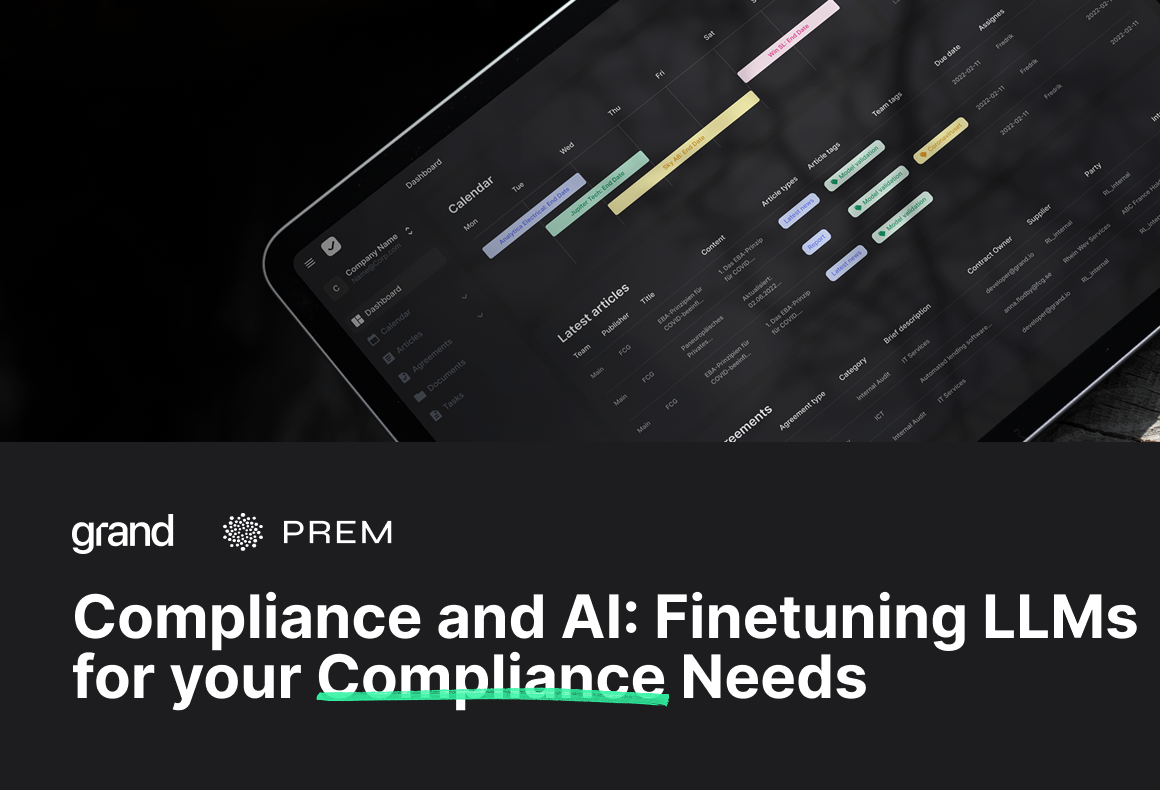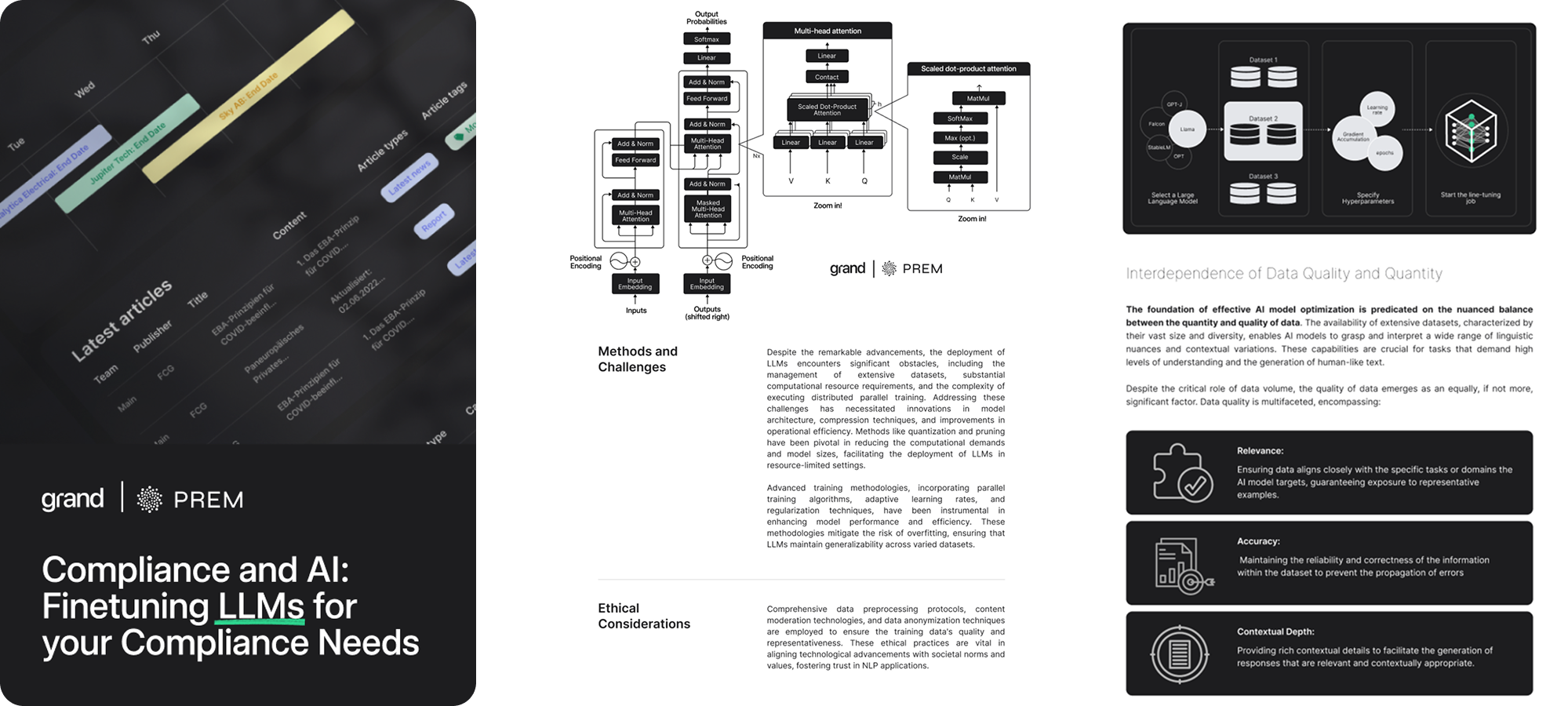Fine-Tuning Large Language Models for Regulatory Compliance

This whitepaper articulates a comprehensive technical framework for adapting large language models (LLMs) to regulatory compliance use cases. It presents an in-depth analysis of modern NLP architectures, specialized fine-tuning methodologies, distributed training approaches, and the integration of retrieval-augmented systems. Concurrently, the framework addresses critical aspects of data security, bias mitigation, and regulatory adherence protocols. It is intended for researchers and practitioners requiring precise guidance on deploying AI-driven models in highly regulated industries.
Contemporary natural language processing (NLP) has evolved considerably, progressing from classical statistical models and recurrent neural network (RNN) architectures to the currently dominant Transformer-based models. These advancements have significantly enhanced the parsing of legal and financial documents, yet regulatory compliance tasks necessitate an additional layer of domain-specific adaptation. This whitepaper outlines a cohesive technical framework that aligns cutting-edge NLP developments with the exacting demands of compliance, emphasizing both advanced fine-tuning techniques and robust security safeguards.

2. Evolution of NLP Architectures in Regulatory Contexts
2.1 Classical Models versus Transformer Architectures
Early statistical approaches, such as n-gram models, provided foundational probabilistic insight yet lacked the capacity to manage long-range linguistic dependencies. Improvements emerged with RNNs and LSTM networks, though computational complexity and vanishing gradients limited their scalability. The advent of the Transformer architecture, marked by its self-attention mechanism, enabled parallelized and context-aware processing—a significant advantage for highly specialized and voluminous regulatory texts.
2.2 Implications for Compliance Tasks
In compliance settings, interpreting legal clauses and financial stipulations with high precision is imperative. Transformer-based models, particularly BERT and GPT variants, excel at capturing nuanced contextual dependencies throughout entire document sequences. This self-attention paradigm supports more comprehensive identification of key regulatory concepts and facilitates clearer distinctions among complex contractual obligations.
3. Domain-Specific Fine-Tuning Methodologies
3.1 Parameter-Efficient Fine-Tuning (PEFT)
Parameter-efficient fine-tuning (PEFT) methods enable practitioners to adapt pre-trained models to regulatory tasks with minimal computational overhead. One approach involves the insertion of small, trainable modules—often referred to as adapter layers—into a frozen pre-trained network. These modules can be fine-tuned independently, effectively specializing the model for compliance contexts without modifying the bulk of its parameters. Another complementary strategy relies on prompt tuning, wherein the input prompt is carefully constructed or modified to steer the model toward compliance-specific outputs, thus preserving the integrity of the original weights.
3.2 Low-Rank Adaptation (LoRA) and Quantized LoRA (QLoRA)
Low-Rank Adaptation (LoRA) introduces trainable low-rank matrices to adjust weight matrices for domain-specific tasks. By focusing on a low-dimensional subspace, LoRA achieves domain adaptation without significantly increasing computational or memory costs. Quantized LoRA (QLoRA) takes this concept further by reducing parameter precision (for example, from 32-bit floating points to 8-bit integers), thereby decreasing computational overhead while preserving performance. These techniques are particularly advantageous when real-time responsiveness and resource efficiency are paramount, which is often the case in regulatory compliance workflows.
3.3 Hyperparameter Optimization
Hyperparameter optimization remains integral to maximizing model performance and ensuring robust convergence. Systematic search strategies, such as grid search or Bayesian optimization, facilitate the exploration of learning rates, batch sizes, dropout probabilities, and weight decay coefficients. Advanced scheduling techniques (e.g., cosine annealing or cyclical learning rates) can help navigate complex loss landscapes. Regularization strategies, encompassing L1/L2 penalties or specialized dropout configurations, help forestall overfitting and maintain broad generalization when confronted with diverse compliance scenarios.
3.4 Data Quality and Augmentation
Data integrity is paramount in compliance-focused training. Ensuring a consistent and high-quality corpus often requires rigorous cleansing and normalization protocols, removing noisy, duplicated, or irrelevant samples. Data augmentation, including synthetic record generation and controlled numerical transformations, can further enhance the training distribution, preparing the model to handle a range of real-world financial and legal texts.
4. Distributed Training and Computational Strategies
4.1 Parallelism and Distributed Architectures
Given the vast size of contemporary LLMs, distributed training strategies are essential. Data parallelism entails partitioning input data across multiple graphics processing units (GPUs), thereby accelerating gradient computations. Model parallelism, in contrast, divides the network’s architecture among different devices, mitigating individual memory limitations. Pipeline parallelism orchestrates a sequential handoff of partial computations across multiple GPUs, promoting concurrency and expediting overall throughput.
4.2 Mixed-Precision and Zero Redundancy Optimization
Mixed-precision training, which employs reduced floating-point precision (often FP16) along with judicious loss scaling, lessens memory usage and accelerates numeric operations. Zero Redundancy Optimization (ZeRO) further optimizes resource utilization by partitioning optimizer states and gradients among parallel devices, thereby minimizing memory redundancy and enabling the fine-tuning of very large models.
4.3 Hardware-Level Accelerations
Implementation details at the hardware level can substantially affect training efficiency. Fine-tuning configurations related to CUDA kernels, cuDNN routines, and asynchronous data transfers can reduce overhead and maximize GPU utilization. Such optimizations are critical in cost-sensitive compliance environments, where efficient resource management is a strategic priority.
5. Integration of Retrieval-Augmented Generation (RAG)
5.1 Dynamic Retrieval Mechanisms
Retrieval-Augmented Generation (RAG) enhances model performance by introducing an external knowledge base that is continuously updated. A separate retrieval module uses similarity search methods to locate the most relevant segments from a vector database containing regulatory, legislative, and financial documents. These retrieved passages are then embedded into the model’s input prompt, effectively grounding responses in real-time information and reducing reliance on a fixed, static set of parameters.
5.2 Computational Efficiency and Output Precision
Because RAG decouples knowledge integration from model weights, it alleviates the need for constant retraining when regulations or financial data shift. This design not only enhances computational efficiency but also augments the factual precision of compliance-oriented outputs by ensuring that time-sensitive or recently updated material is reflected in each inference cycle.
6. Ethical, Security, and Regulatory Compliance Considerations
6.1 Bias Mitigation and Explainability
In highly regulated domains, bias mitigation and transparent decision-making processes are fundamental. Bias detection audits, facilitated by algorithmic tools and systematic reviews, help ensure equitable results across demographic and geographic segments. Explainable AI (XAI) strategies, such as attention-weight visualizations and feature attribution methods, promote transparency and bolster stakeholder trust in AI systems deployed for compliance functions.
6.2 Data Security and Access Control
Strict data security protocols are indispensable when handling sensitive financial or legal information. Comprehensive encryption—at rest (e.g., AES-based) and in transit (e.g., TLS)—safeguards data integrity. Role-based access control (RBAC), combined with multi-factor authentication (MFA) and detailed audit trails, further restricts unauthorized data access. Compliance with international standards, including GDPR, HIPAA, and ISO 27001, is reinforced through routine Data Protection Impact Assessments (DPIAs) that preemptively address emerging data protection risks.
7. Transformative Compliance Applications and Operational Integration
7.1 Automated Regulatory Monitoring and Reporting
Fine-tuned LLMs, when augmented with retrieval-based systems, support continuous monitoring of legislative databases and regulatory announcements. Real-time summarization methods distill extensive compliance documents into actionable insights, mitigating the manual workload typically associated with cataloging and interpreting new or evolving rules.
7.2 Enhanced Risk Assessment and Predictive Analytics
Domain-adapted models can detect early signals of potential non-compliance in operational workflows. Such systems leverage advanced text processing to uncover latent risk indicators and to fuel predictive analytics that forecast compliance breaches. These predictive capabilities enable organizations to intervene proactively, thereby reducing the likelihood of costly violations or fines.
7.3 Custom-Built Compliance Platforms
The proposed framework lays the groundwork for integrated compliance ecosystems capable of managing policy interpretation, vendor risk assessments, and regulatory change management. Automated policy interpretation systems can generate and update procedural guidelines in response to real-time legislative changes, while AI-driven monitoring tools continuously evaluate third-party partners for compliance risks. These platform-level solutions expedite the deployment of standardized and adaptive compliance measures across an organization.
7.4 Secure On-Premise and Hybrid Cloud Deployments
The framework’s architectural flexibility accommodates a range of deployment models, including on-premise solutions designed to maintain full data sovereignty, private cloud setups offering robust security within scalable infrastructures, and hybrid approaches combining the best of both worlds. This versatility is essential for organizations with varied data governance requirements and security priorities.
Reduce your
compliance risks

